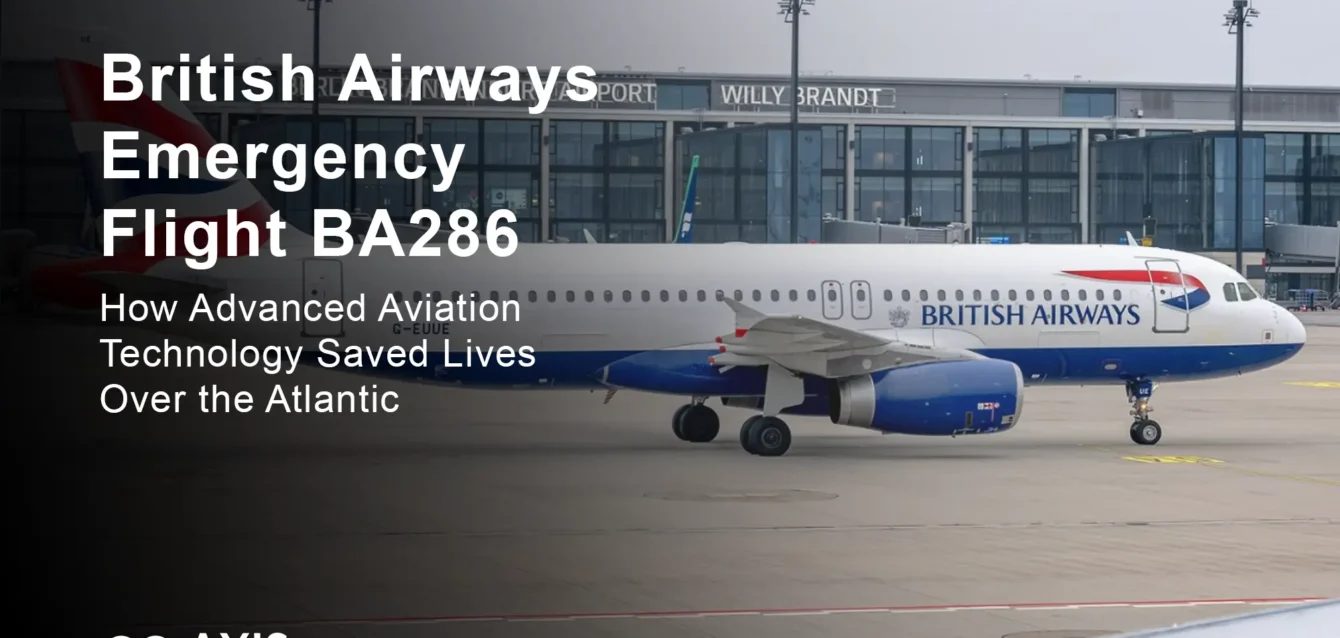British Airways Emergency Flight BA286
When British Airways flight BA286 transmitted squawk code 7700 over Scotland at 41,000 feet on May 26, 2025, it triggered a cascade of technological systems that demonstrated exactly why modern aviation represents one of humanity’s greatest safety achievements. This wasn’t just another emergency landing story—it was a masterclass in how integrated aviation technology, from the Airbus A380’s sophisticated medical communication systems to real-time tracking networks, can mean the difference between life and death at cruising altitude.
The incident, involving registration G-XLEG on the San Francisco to London route, offers unprecedented insights into how airlines leverage technology to handle critical situations. Here’s everything you need to know about what really happened, the technology that made the difference, and why this event matters for the future of aviation safety.
Table des matières
- The Emergency Unfolds: Real-Time Technology Response
- Squawk 7700: Understanding Aviation’s Digital SOS
- BA286 Route Analysis: Why This Flight Matters
- A380 Medical Emergency Systems: Technology That Saves Lives
- Communication Technology: From Aircraft to Ground in Seconds
- British Airways Fleet Technology: The A380 Advantage
- Emergency Landing Protocols: Data-Driven Decision Making
- Medical Emergency Technology: Beyond Basic First Aid
- Air Traffic Control Integration: Seamless Emergency Response
- Future of Aviation Emergency Response
The Emergency Unfolds: Real-Time Technology Response {#emergency-unfolds}
At 19:33 PDT on May 26, 2025, BA286 departed San Francisco International Airport for what should have been a routine 10-hour flight to London Heathrow. The Airbus A380, with registration G-XLEG, was cruising at 41,000 feet over Scotland when the crew squawked 7700—the international emergency code—due to a medical emergency on board.
But here’s what most reports missed: the sophisticated web of technology that immediately sprang into action. The moment that four-digit code appeared on radar screens, multiple systems across the Atlantic began coordinating what would become a textbook emergency response.
The A380’s Network Server System (NSS), essentially the aircraft’s digital nervous system, was simultaneously managing passenger entertainment, crew communications, and critical flight data while the emergency unfolded. This distributed computing architecture, unique to the A380, allowed the crew to maintain full operational capability even while dealing with the medical crisis.
Within minutes of declaring the emergency, pilots were coordinating with London Heathrow for priority landing, demonstrating the efficiency of modern aviation communication protocols. The aircraft touched down safely on runway 27L at 13:39 BST, with the patient receiving immediate medical attention at stand C56.
Real-Time Tracking Technology in Action
Flight tracking platforms like FlightRadar24 and AirNav Radar captured this emergency in real-time, providing transparency that didn’t exist even a decade ago. When G-XLEG began transmitting the 7700 code, aviation enthusiasts and industry professionals worldwide could follow the situation as it developed, creating an unprecedented level of public awareness about aviation emergency procedures.
This transparency, enabled by Automatic Dependent Surveillance-Broadcast (ADS-B) technology, represents a fundamental shift in how we experience aviation emergencies. The public can now witness the precision and professionalism that characterize modern emergency response, building confidence in aviation safety systems.
Squawk 7700: Understanding Aviation’s Digital SOS {#squawk-7700}
The decision to squawk 7700 represents more than just pressing buttons on a transponder. When an aircraft transmits this emergency code, all air traffic control facilities in the area are immediately alerted that the aircraft has an emergency situation requiring priority handling.
What Is Squawk 7700 Emergency Code?
Squawk 7700 is a four-digit emergency transponder code that immediately alerts air traffic control to aircraft emergencies. This universal code, established by the International Civil Aviation Organization (ICAO), serves as a “catch-all” emergency signal for any situation requiring immediate assistance.
When pilots input squawk 7700 into their transponder, the code automatically appears on radar screens at all relevant air traffic control facilities. This instant notification system ensures that controllers can provide priority handling, clear airspace, and coordinate emergency response without relying solely on radio communication.
The emergency squawk codes include:
- 7500: Aircraft hijacking or unlawful interference
- 7600: Communication/radio failure
- 7700: General emergency (medical, mechanical, or other critical situations)
How Squawk 7700 Technology Works: Modern transponders operate on a sophisticated interrogation-response system, transmitting on 1090 MHz in response to radar interrogation signals. The Mode S transponder technology used on aircraft like the BA286 A380 provides additional data including aircraft altitude, speed, and identification information.
Emergency Code Definitions for Featured Snippets
What does squawk 7700 mean? Squawk 7700 is the universal aviation emergency code that alerts air traffic control to any general emergency situation requiring immediate assistance, including medical emergencies, mechanical failures, or other critical aircraft issues.
BA286 emergency May 2025 quick facts:
- Date: May 26, 2025
- Aircraft: Airbus A380 (Registration G-XLEG)
- Route: San Francisco (SFO) to London Heathrow (LHR)
- Emergency Type: Medical emergency on board
- Altitude When Declared: 41,000 feet over Scotland
- Landing Time: 13:39 BST on runway 27L
- Résultats: Safe landing, passenger received immediate medical care
Emergency squawk codes meaning:
- 7500 = Hijacking (unlawful interference)
- 7600 = Communication failure (radio malfunction)
- 7700 = General emergency (medical, mechanical, or other urgent situations)
- Clear airspace around the affected aircraft
- Coordinate with medical facilities at the destination airport
- Alert emergency services for immediate response upon landing
- Provide priority routing and altitude clearances
The emergency declaration gives pilots authority to deviate from standard procedures, including speed limits and airspace restrictions, to ensure passenger safety. This regulatory flexibility, embedded in international aviation law, recognizes that emergency situations require immediate, decisive action.
Advanced Transponder Technology
The A380’s Mode S transponder goes beyond basic emergency signaling. It provides detailed flight data including:
- Precise altitude measurements using barometric sensors
- Aircraft speed and heading information
- Automatic collision avoidance data
- Emergency service coordination protocols
When BA286 transmitted 7700, ground controllers received not just an emergency alert but a comprehensive data package that allowed them to make informed decisions about routing, landing priorities, and resource allocation.
BA286 Route Analysis: Why This Flight Matters {#route-analysis}
BA286 operates as part of British Airways’ premium transatlantic service, connecting San Francisco International Airport with London Heathrow using the airline’s flagship A380 aircraft. This route represents one of the most technologically demanding operations in commercial aviation.
Route Technology Challenges
The San Francisco-London route covers approximately 5,350 nautical miles, requiring sophisticated navigation systems, weather monitoring, and communication protocols. Key technological considerations include:
Oceanic Airspace Management: Once aircraft leave coastal radar coverage, they rely on satellite-based navigation and communication systems. The A380’s advanced avionics suite includes multiple redundant systems for oceanic operations.
Weather Radar Integration: The route crosses multiple weather systems, requiring real-time meteorological data integration. The A380’s weather radar system can detect turbulence and precipitation patterns up to 320 nautical miles ahead.
Fuel Management Systems: Advanced algorithms continuously calculate optimal altitude and speed profiles to maximize fuel efficiency while maintaining schedule reliability.
Stratégie de déploiement de la flotte
British Airways operates daily A380 service between San Francisco and London, supplemented by Boeing 777 service, as part of their strategy to maximize capacity on slot-constrained routes. This dual-aircraft approach leverages different technological capabilities:
- A380: High-capacity, advanced medical facilities, superior passenger comfort
- Boeing 777: Operational flexibility, lower operating costs, similar range capability
The May 2025 incident demonstrated why British Airways’ A380 deployment makes strategic sense. The aircraft’s medical facilities and communication systems provided capabilities that might not have been available on smaller aircraft.
A380 Medical Emergency Systems: Technology That Saves Lives {#a380-medical}
The Airbus A380 represents the pinnacle of aviation medical technology. British Airways’ A380 fleet includes 12 aircraft, each with a passenger capacity of 469 across four classes, equipped with comprehensive medical emergency systems.
Advanced Medical Equipment
Every British Airways A380 carries medical equipment that rivals many hospital emergency departments:
Enhanced Medical Kit: Beyond basic first aid supplies, the A380 medical kit includes:
- Automated External Defibrillator (AED) with pediatric capabilities
- Advanced airway management tools
- Cardiac medications including epinephrine and atropine
- Blood pressure monitoring equipment designed for aircraft noise environments
- Pulse oximetry with altitude compensation algorithms
Telemedicine Integration: The A380’s satellite communication system enables real-time consultation with ground-based medical professionals. This telemedicine capability allows ground-based professionals to observe patient conditions, assess symptoms, and provide accurate guidance for flight crew implementation.
Communication System Architecture
The A380’s Network Server System (NSS) serves as the digital backbone for all aircraft systems, including medical emergency communications. This sophisticated interface system connects the crew with external medical support while maintaining all other aircraft operations.
The NSS enables:
- Real-time video consultation with medical specialists
- Transmission of vital signs data to ground-based physicians
- Coordination with destination hospital facilities
- Documentation of medical interventions for continuity of care
Cabin Environment Management
The A380’s environmental control system plays a crucial role in medical emergencies. The aircraft maintains cabin pressure equivalent to 6,000-8,000 feet altitude, with advanced filtration systems that provide hospital-grade air quality.
During medical emergencies, cabin crew can:
- Adjust oxygen delivery systems for individual passenger needs
- Modify cabin lighting to support medical procedures
- Create sterile work areas using the aircraft’s advanced cleaning systems
- Isolate affected areas if necessary for infectious disease protocols
Communication Technology: From Aircraft to Ground in Seconds {#communication-tech}
When BA286 declared an emergency, multiple communication channels activated simultaneously, creating a comprehensive information network that extended from the cockpit to hospitals in London.
Satellite Communication Systems
The A380’s satellite communication (SATCOM) system provides global coverage using multiple satellite networks:
Inmarsat Network: Primary communication for oceanic flights, providing voice, data, and emergency messaging capabilities with 99.9% availability.
Iridium Constellation: Backup communication system offering pole-to-pole coverage with low-latency data transmission for emergency situations.
ACARS Integration: Automatic data transmission system that continuously updates ground stations with aircraft position, system status, and emergency notifications.
Air Traffic Control Coordination
When BA286 squawked 7700, the emergency code was automatically distributed to all relevant air traffic control facilities, creating a coordinated response across international boundaries.
The coordination process involves:
- Immediate Alert: Emergency code triggers automated alerts at all relevant control centers
- Priority Routing: Air traffic management systems automatically calculate optimal approach routes
- Airport Notification: Heathrow Airport operations receive advance warning to prepare medical facilities
- Resource Allocation: Emergency services position equipment and personnel for immediate response
Medical Support Integration
British Airways partners with MedAire, a specialist aviation medical support service, to provide 24/7 emergency consultation. Advanced telemedicine systems can transmit 12-lead electrocardiographs, pulse oximetry, blood pressure, and temperature data, along with video communications directly to medical professionals.
This integration means that when a medical emergency occurs, the patient essentially has access to a virtual emergency department at 41,000 feet, with specialists providing real-time guidance to trained cabin crew.
British Airways Fleet Technology: The A380 Advantage {#fleet-tech}
British Airways operates a sophisticated fleet including Airbus A350, A380, Boeing 777, and 787 aircraft, with the A380 representing the flagship of long-haul operations. The technological advantages of the A380 become apparent during emergency situations.
Advanced Avionics Integration
The A380’s fly-by-wire system includes multiple layers of safety protection that function even during emergencies:
Flight Envelope Protection: Prevents aircraft from exceeding safe operational limits, even if pilots are distracted by emergency procedures.
Automatic Systems Management: Critical aircraft systems continue operating autonomously, allowing crew to focus on emergency response.
Redundant Navigation: Multiple independent navigation systems ensure flight path accuracy even with system failures.
Power and Systems Reliability
The A380’s four Rolls-Royce Trent 900 engines provide multiple levels of redundancy, with each engine capable of powering essential aircraft systems independently.
During the BA286 emergency, this redundancy ensured:
- Continuous electrical power for medical equipment
- Reliable cabin pressurization and environmental control
- Uninterrupted communication system operation
- Full navigation and flight management capability
Passenger Comfort During Emergencies
The A380’s advanced cabin design includes superior noise reduction and vibration control, creating an environment conducive to medical care even during emergency situations.
Technical features include:
- Advanced vibration dampening systems that reduce motion sensitivity
- Noise reduction technology that enables clear communication
- Spacious cabin layout allowing medical intervention access
- Independent zone environmental control for patient comfort
Emergency Landing Protocols: Data-Driven Decision Making {#landing-protocols}
The BA286 emergency landing demonstrated the sophistication of modern aviation decision-making systems. Rather than relying solely on pilot judgment, emergency responses now integrate multiple data sources to optimize outcomes.
Predictive Analytics in Emergency Response
Modern aircraft generate thousands of data points per second, and emergency situations trigger advanced analytics systems that:
Calculate Optimal Landing Weight: Algorithms determine whether fuel dumping is necessary based on aircraft weight, runway conditions, and emergency severity.
Weather Integration: Real-time meteorological data influences approach planning, runway selection, and emergency service positioning.
Airport Resource Management: Automated systems coordinate gate assignments, medical facility preparation, and passenger handling logistics.
Performance Monitoring Systems
BA286’s successful emergency landing was supported by continuous performance monitoring systems that tracked aircraft condition throughout the approach and landing sequence.
These systems monitor:
- Engine performance parameters
- Structural stress indicators
- Hydraulic and electrical system status
- Landing gear condition and deployment status
Post-Emergency Analysis
Modern aviation emergency response includes comprehensive data analysis for continuous improvement. The BA286 incident will generate detailed reports analyzing:
- Response time metrics from emergency declaration to landing
- Communication effectiveness between crew, ATC, and medical support
- Resource utilization efficiency at London Heathrow
- Medical intervention outcomes and procedural effectiveness
This data feeds into industry-wide safety databases, contributing to improved emergency response protocols for future incidents.
Medical Emergency Technology: Beyond Basic First Aid {#medical-tech}
The technology available during the BA286 medical emergency extends far beyond traditional first aid concepts. Modern aviation medical support represents a convergence of aerospace engineering, medical technology, and telecommunications.
Wearable Health Monitoring
Emerging wearable health monitor technology allows real-time monitoring of vital signs for passengers prone to medical complications, providing early warning systems that can prevent emergencies from escalating.
Advanced implementations include:
- Continuous heart rate and rhythm monitoring
- Blood oxygen saturation tracking with altitude compensation
- Automated emergency alerts when parameters exceed safe thresholds
- Integration with aircraft medical systems for immediate data transmission
Intégration de l'intelligence artificielle
AI and machine learning technologies are beginning to analyze data from onboard medical incidents to predict potential emergencies and suggest preventive measures.
AI applications in aviation medicine include:
- Pattern recognition for early symptom identification
- Treatment protocol optimization based on altitude and cabin environment
- Resource allocation algorithms for medical equipment deployment
- Predictive modeling for emergency diversion decision support
Telemedicine Platform Evolution
The next generation of aviation telemedicine goes beyond simple voice communication. Advanced platforms now support:
High-Definition Video Consultation: Satellite bandwidth improvements enable HD video calls with medical specialists, allowing visual assessment of patient condition.
Real-Time Vital Signs Transmission: Systems can transmit 12-lead electrocardiographs, pulse oximetry, end tidal capnography, pulse, blood pressure, and temperature data directly to ground-based medical professionals.
Electronic Medical Record Integration: Patient data can be securely transmitted to destination hospitals, ensuring continuity of care upon landing.
Medication Interaction Analysis: AI-powered systems can analyze passenger medications and recommend safe emergency treatments.
Air Traffic Control Integration: Seamless Emergency Response {#atc-integration}
The BA286 emergency response showcased the sophisticated integration between aircraft systems and ground-based air traffic management technology.
Automated Emergency Detection
Modern air traffic control systems use artificial intelligence to automatically detect emergency situations:
Anomaly Detection Algorithms: Advanced pattern recognition systems identify unusual flight profiles that may indicate emergencies before crews declare them.
Predictive Routing Systems: AI calculates optimal emergency approach routes considering weather, traffic, and airport capacity constraints.
Resource Optimization Platforms: Automated systems coordinate emergency service deployment, runway preparation, and traffic flow management.
International Coordination Protocols
Emergency code 7700 triggers automated coordination between international air traffic control systems, ensuring seamless handoff between control centers across different countries.
This coordination includes:
- Automatic data sharing between Eurocontrol and UK air traffic systems
- Real-time weather and runway condition updates
- Emergency service notification protocols
- International medical support coordination
Communication System Redundancy
Emergency situations require multiple backup communication channels:
Primary VHF Radio: Standard air-ground communication for normal situations Secondary UHF Systems: Military and emergency frequency backup capabilities Satellite Communication: Global coverage for oceanic and remote area emergencies ACARS Data Link: Automated text messaging for critical information transfer Emergency Locator Transmitters: Automatic distress signals in extreme situations
Future of Aviation Emergency Response {#future-tech}
The BA286 incident provides insights into how aviation emergency response continues evolving through technological advancement.
Next-Generation Medical Equipment
Future aircraft medical systems will include:
Portable Ultrasound Systems: Compact devices enabling detailed internal examination capabilities at altitude.
Advanced Diagnostic Platforms: Integration of laboratory-quality blood analysis equipment for comprehensive patient assessment.
Robotic Assistance Systems: AI-guided medical intervention robots to support cabin crew during complex procedures.
Personalized Medicine Integration: Systems that access passenger medical histories and provide customized treatment recommendations.
Enhanced Communication Technology
Future telemedicine systems will provide standardized protocols across airlines, ensuring uniformity and compatibility for emergency response procedures.
Developments include:
- 5G satellite networks providing hospital-quality communication bandwidth
- Holographic medical consultation technology
- Real-time medical imaging transmission capabilities
- Integrated electronic health record access systems
Predictive Emergency Prevention
The future of aviation medicine focuses on preventing emergencies before they occur:
Pre-Flight Health Assessment: Advanced screening technology to identify passengers at risk Environmental Monitoring: Real-time cabin condition assessment for health optimization Stress Response Analysis: Biometric monitoring to detect passenger anxiety and health risks Personalized Flight Recommendations: AI-powered systems suggesting optimal travel conditions for individual health profiles
Questions fréquemment posées
What happened to British Airways flight BA286 in May 2025?
British Airways flight BA286 declared an emergency on May 26, 2025, while flying from San Francisco to London Heathrow. The Airbus A380 (registration G-XLEG) squawked emergency code 7700 at 41,000 feet over Scotland due to a medical emergency on board. The aircraft received priority landing at London Heathrow, touching down safely on runway 27L at 13:39 BST, with the patient receiving immediate medical attention.
What does squawk 7700 mean in aviation emergencies?
Squawk 7700 is the international emergency transponder code used for general emergencies. When pilots set this four-digit code, it immediately alerts all air traffic control facilities that the aircraft requires priority handling. The code can indicate medical emergencies, mechanical failures, or any situation requiring immediate assistance. Unlike squawk 7500 (hijacking) or 7600 (communication failure), 7700 serves as a catch-all emergency signal.
Why do aircraft emergency squawk codes exist?
Emergency squawk codes provide instant, silent communication between aircraft and air traffic control. These four-digit transponder codes (7500, 7600, 7700) were established by the International Civil Aviation Organization (ICAO) to ensure rapid emergency response. When verbal communication is impossible or time-critical, pilots can alert controllers to specific emergency types without radio contact.
How does British Airways A380 medical emergency equipment work?
The A380 carries hospital-grade medical equipment including automated external defibrillators, advanced airway management tools, cardiac medications, and real-time telemedicine systems. The aircraft’s Network Server System (NSS) enables video consultation with ground-based medical specialists, vital signs transmission, and coordination with destination hospitals. This technology transforms the aircraft into a flying medical facility.
What is the BA286 flight route and schedule?
BA286 operates daily service from San Francisco International Airport to London Heathrow using British Airways’ Airbus A380 aircraft. The route covers approximately 5,350 nautical miles with a scheduled flight time of 10 hours. British Airways supplements this A380 service with Boeing 777 flights, maximizing capacity on this premium transatlantic route.
How often do medical emergencies occur on commercial flights?
In-flight medical emergencies occur in 24 to 130 cases per 1 million passengers. Up to 70% of these emergencies are managed by cabin crew without additional medical assistance. The most common issues include syncope (fainting), gastrointestinal problems, and respiratory complaints, while cardiovascular events most frequently trigger flight diversions.
What emergency landing procedures does British Airways follow?
British Airways emergency landing procedures involve immediate ATC coordination, medical consultation, airport preparation, and emergency service deployment. Advanced algorithms calculate optimal approach routes, fuel requirements, and resource allocation. The process includes real-time weather assessment, runway clearing, and medical facility preparation at the destination airport.
How do air traffic controllers respond to squawk 7700 emergencies?
When aircraft squawk 7700, air traffic controllers immediately provide priority routing, clear surrounding airspace, and coordinate emergency response. Automated systems alert multiple control centers simultaneously, calculate optimal approach vectors, and notify destination airports. Controllers maintain continuous communication while preparing ground emergency services for immediate assistance.
What aviation technology prevents medical emergencies?
Modern aviation medical technology includes wearable health monitors, AI-powered prediction systems, and advanced pre-flight health assessments. Emerging systems monitor passenger vital signs in real-time, analyze medical data for early warning detection, and provide personalized health recommendations for air travel. Future developments focus on preventing emergencies before they occur.
What communication systems do aircraft use during emergencies?
Emergency aircraft communication uses multiple redundant systems including VHF radio, satellite communication (SATCOM), ACARS data links, and emergency locator transmitters. The A380’s advanced communication suite provides global coverage through Inmarsat and Iridium satellite networks, enabling real-time consultation with medical specialists and seamless coordination with air traffic control.
How does aircraft cabin pressure affect medical emergencies?
Commercial aircraft maintain cabin pressure equivalent to 6,000-8,000 feet altitude, which can exacerbate certain medical conditions. The reduced oxygen partial pressure and 30% gas expansion can affect passengers with cardiovascular or respiratory issues. Modern environmental control systems include oxygen delivery capabilities and hospital-grade air filtration to support emergency medical care.
What medical training do flight attendants receive?
British Airways cabin crew receive comprehensive medical training including CPR, AED operation, first aid procedures, and emergency medical kit usage. Training covers recognition of common in-flight medical conditions, communication with ground-based medical support, and coordination with volunteer medical professionals during emergencies.
How does the BA286 incident compare to other aviation emergencies?
The BA286 medical emergency represents a successful example of modern aviation safety systems working as designed. Unlike mechanical emergencies or severe weather diversions, medical emergencies rely heavily on communication technology and onboard medical facilities. The incident demonstrated the effectiveness of integrated emergency response protocols across international airspace.
What happens to passengers during aircraft medical emergencies?
During medical emergencies, aircraft systems maintain normal operations for unaffected passengers while creating isolated treatment areas. Modern aircraft like the A380 use redundant systems to ensure continuous operation, with cabin crew trained to manage emergencies without disrupting overall passenger comfort and safety.
How will future technology improve aviation emergency response?
Future aviation emergency technology includes enhanced AI diagnostics, 5G satellite networks, holographic medical consultation, and predictive health monitoring. Developments focus on preventing emergencies through advanced passenger screening, providing hospital-quality care at altitude, and enabling seamless integration between aircraft and ground medical facilities.
Technology Saving Lives at 41,000 Feet
Le British Airways flight BA286 emergency on May 26, 2025, represents far more than a successful emergency response—it demonstrates how integrated technology systems create multiple layers of safety protection that function seamlessly even under pressure. From the moment the crew squawked 7700 over Scotland to the safe landing at London Heathrow, every system performed exactly as designed.
The A380’s sophisticated medical equipment, communication systems, and flight management technology worked in perfect coordination with ground-based air traffic control, medical support services, and emergency response teams. This level of integration, unimaginable just decades ago, now represents the standard for commercial aviation safety.
Looking forward, the lessons learned from incidents like BA286 continue driving innovation in aviation medical technology. As AI, telemedicine, and predictive analytics become more sophisticated, we’re moving toward a future where medical emergencies at altitude become increasingly rare and, when they do occur, are managed with even greater precision and effectiveness.
The 469 passengers and crew aboard BA286 experienced firsthand why commercial aviation remains the safest form of long-distance travel. Behind every successful emergency response lies thousands of hours of engineering, countless safety innovations, and the dedication of professionals who understand that in aviation, technology doesn’t just enhance convenience—it saves lives.





